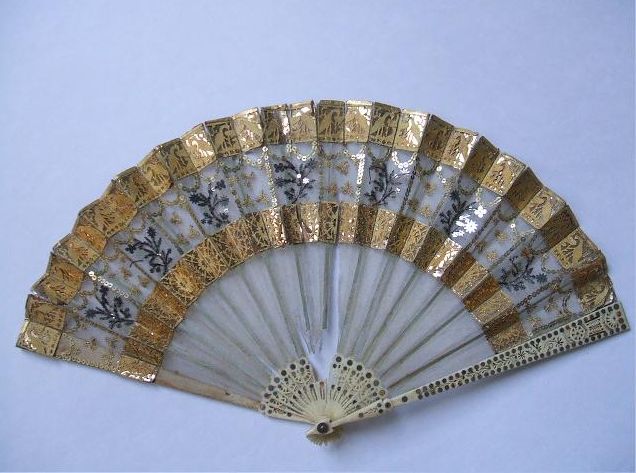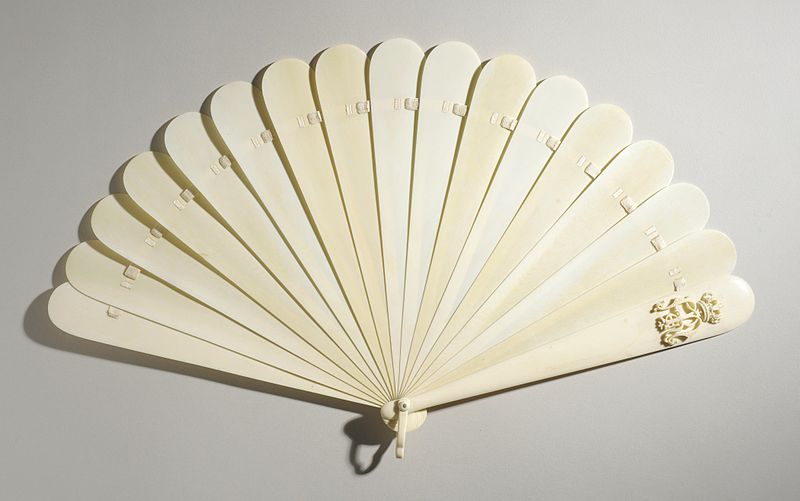"Men have the sword, women have the fan and the fan is probably as effective a weapon!" --Joseph Addison
Cleopatra's slaves used them to keep her comfortable as she sailed on her barge. The Chinese associated them with mythical characters. The folding variety we all recognize originated in Japan, but China became famous for them. Once they arrived in Europe around 1550 with traders from the far east, they became a plaything of the nobility. Nowadays, I seldom see them, except on warm summer Sunday mornings when a woman inevitably puts one to use during church services.
Fans have come a long way, baby.
 |
Anatomy of the fan |
 |
| Lady Holding a Fan by Francesco Bartolozzi |
Folding fans seem to have come in three types: the plain old folding type (yes, the name sounds obvious) is where a set of sticks is fastened together at one end and pleated material (silk, leather, or other fabric) is fastened to the sticks. (Feathers and lace, by the way, went in and out of fashion.)
 |
| Public Domain |
Ladies also used cockade fans, which are pleated paper attached to two sticks. They open into a full circle with the end sticks forming a handle--although I have not seen them in portraits or read of ladies using them at balls. However, I am not an expert. Just passing along the info.
 |
| Courtesy of York Museums Trust |
 |
| Public domain, courtesy of LACMA |
Painted fans were certainly popular, and often depicted pastoral, Asian, mythological, or Biblical scenes. In the eighteenth-century through the Regency period, Vernis Martin fans were valued. Vernis (French for varnish) was a technique developed by the Martin brothers, who hand-painted the scenes. This Vernis Martin Fan had mother-of-pearl guards.
Apparently, ladies painted images on their own fans, too: Princess Augusta, aunt of Queen Victoria, painted one that now belongs to her Majesty, Queen Elizabeth II. According to documentation, it was created around 1790 and the medallions painted on the panels were done by "one of George III's daughters."
Here enters the so-called Language of the Fan.The fan was no longer a pretty frippery, or a cooling device, but also a method to convey secret codes.
The notion probably began as an advertising technique by fan-makers, but Fan Languages were published in contemporary magazines and books on etiquette. Charles Francis Badini wrote a book called Fanology or Ladies’ Conversation Fan, which was published in 1797. It listed many gestures along with the secret codes they conveyed, including:
Carrying Open fan: come speak with me
Twirling the fan in the right hand: I love another
Twirling the fan in the left hand: We are being watched
Placing the fan near your heart: I love you
A half-closed fan pressed to the lips: You may kiss me
Letting the fan rest on the right cheek: Yes
Letting the fan rest on the left cheek: No
Dropping the fan: We will be friends
Other sources decoding fan language offer some pretty specific statements:
Placing fan on left ear: I wish to be rid of you
Carrying fan in right hand in front of face: Follow me
Drawing fan across the forehead: You have changed
Drawing fan through the hand: I hate you
Threaten with shut fan: You are imprudent
Gazing at shut fan: Why do you misunderstand me?
Perhaps he misunderstands because this gets so complicated, m'dear. While many a female no doubt practiced these motions before the looking glass, one wonders how many gentlemen scratched their bewigged heads in utter cluelessness. Also, how many matchmaking mamas were so oblivious that they wouldn't understand what it meant when her daughter threatened a suitor with a shut fan?
The Language of the Fan seems to fallen out of vogue for a generation: the Regency. Fans were still an essential accessory, however. This Regency lady is ready for a magical evening at Lord and Lady Fabulous' ball. She is wearing her gown of pink crepe, a toque on her head, elbow-length kid gloves, her satin slippers, and carries--of course, her fan. She may not use it to send secret codes, but no fashion-minded, status-conscious British lady of the 18th and 19th century would attend a ball without one.
 | ||
Rolinda Sharples' painting, Cloak Room, Clifton Assembly Room, was painted in 1817. Look at all these Regency ladies holding their fans! It might be difficult to view, but many of the fans appear to be white or sheer.
 |
| Cloak Room, Clifton Assembly Room, 1817, Rolinda Sharples |
The Victorians took fans to a whole different level. French maisons created fans for the very wealthy. Tablitiers carved exquisite sticks, and famous artists painted (and signed) fans. As the language of flowers became popular again, no doubt the language of the fan refreshed, as well.
 |
| "The Political Lady" by James Tissot, 1884. Get a load of her feather fan! And gorgeous gown... |
Alas, fans as a fashion statement seem to have gone the way of the elbow-length glove and the bonnet. So for now, my experience with gorgeous fans will have to be limited to my imagination, when my characters use them to their advantage.
But to you, I will drop my fan. (Translation: we will be friends. Although that totally isn't what it sounds like to me.)
***
Your Turn: Do you own a fan?
BIO:
Susanne Dietze began writing love stories in high school, casting her friends in the starring roles. Today, she's the award-winning author of ten new and upcoming historical romances who's seen her work on the ECPA and Publisher's Weekly Bestseller Lists for Inspirational Fiction. Next month sees the release of "The Honeymoon Express" novella in The Rails to Love Collection. Married to a pastor and the mom of two, Susanne loves fancy-schmancy tea parties, travel, and curling up on the couch with a costume drama and a plate of nachos.
Fan Anatomy: http://www.thefanmuseum.org.uk/
Folding fan: http://collections.vam.ac.uk/item/O78760/folding-fan-and-unknown/
Cockade fan: http://collections.vam.ac.uk/item/O70089/fan-unknown/
Brise fan: fitzmuseum.cam.ac.uk
Princess Augusta's fan: www.royalcollection.org.uk/collection
Regency lady: http://regency-clothing.blogspot.com/2012/05/regency-era-fashion-plates-april-1812.html
The Political Lady: http://www.zazzle.com/the_political_lady_by_james_tissot_poster-228780734008503372
A variation of this post originally appeared on Inkwell Inspirations
A variation of this post originally appeared on Inkwell Inspirations



I have a beautiful painted fan that belonged to my best friend. I loved learning how ladies managed to converse with gentlemen in a day when proper introductions had to be made first. Creative minds always find a way, don't they.
ReplyDeleteStephanie, your fan sound like a treasure. What a precious gift!
DeleteCreative minds do indeed find a way. I'm sure many a teenage lady was fluent in the language of the fan. I imagine I would have been, too!
Thanks for coming by.
Yes, I do. A school friend brought me one back from her family visit to Japan back in the early 70's. I've always loved flicking it open.
ReplyDeleteGreat post, Susie.
What a delightful souvenir, Anita Mae! It must be lovely.
DeleteI attended a wedding this summer where the bride and groom offered fans for the guests to stay cool during the ceremony. Isn't that a neat idea?
Thanks, Anita Mae!
Susie, thank you so much for sharing this interesting post. I'm impressed with how much there is to remember!
ReplyDeletehahaha...with my hot flashes, I am never without some kind of fan. My favorite type is the folded kind with designs. I love these pictures. Thanks for sharing.
ReplyDelete